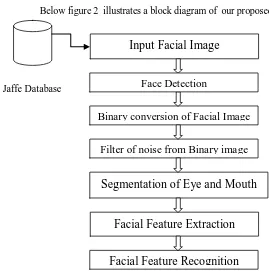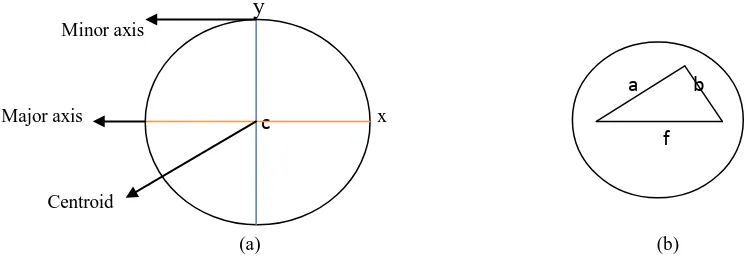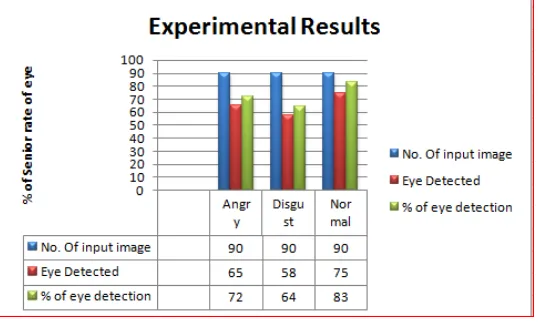Available Online at www.ijcsmc.com
International Journal of Computer Science and Mobile Computing
A Monthly Journal of Computer Science and Information Technology
ISSN 2320–088X
IMPACT FACTOR: 5.258
IJCSMC, Vol. 5, Issue. 5, May 2016, pg.407 – 415
Segmentation of Facial Features Based
on Human Face Expressions
Manasa B
1, Dr. Prasad M
21
M.Tech IV sem, Student, Dept. Of CSE, UBDTCE, Davangere, India
2
Assistant Professor, Dept. Of MCA, Bapuji Institute of Engineering & Technology, Davanagere-4, India
1
Manasa.b2012@gmail.com, 2 Prasad.marpalli@gmail.com
Abstract— Facial expressions are the important and successful requirement in image analysis in the field of image processing. Facial expressions are mainly based on mouth and eye for analyzing and recognizing the human mood. Many segmentation techniques are available for to analyze and recognize the facial expressions based on human mood. The main aim of facial expressions is to recognize the facial features such as mouth and eye from an given input facial image. Mouth and eye are extracted by applying the appropriate threshold value to the given image by using statistical features such as operations like right array division and right array multiplication. Experiments are carried out on Japanese Female Facial Expressions (JAFFE) a facial expression database [11] and in terms of accuracy we obtained better performance in our proposed method.
Keywords— Facial Expression Recognition, Feature Extraction, Segmentation, Major axis length and Minor axis length
I. INTRODUCTION
In everyone’s daily lifeline, in so many times we may frequently change their face depends upon situations. These changes can we seen in their own faces are called “Facial Expressions”. So the Facial expressions are important features of every human being. By seeing changes in everyone’s face, we can understand a lot to express our words or phrases. Hence a facial expression plays a vital role in everyday’s life to understand the emotions of every human being.
Therefore facial expressions are really the most powerful and natural means for every human being to communicate and share their feelings, emotions and also their intentions. These expressions carry some information about mental status, emotional and also physical states of communication between the human beings to make their conversations. Finally we can say that a facial expression contains key features to express our emotions based on situations occurs and it plays a crucial role for non-verbal communication.
Human brain can recognize facial expression just by facial shape features. Shape features have some characteristics they are, the dimension of feature vector is small and the computational complexity of training and recognizing is low. From last 20 years the facial expression recognition was primarily a research subject for computer science [1].
In different areas like attention level estimation, data-driven animation and human-robot interaction, an Automatic facial expression analysis can be used. Automatic facial expression recognition has become a significant research due to its potential applications in recent years. It consists of three major steps: face detection, facial feature representation and extraction, and classification. However, recognizing facial expression automatically and accurately remains difficult due to the variability and complexity of human faces as well as facial expressions [3].
Humans can easily recognize facial expressions without any effort or delay, but facial recognition by a machine is still a challenge. Some of its challenges are highly dynamic in their Orientation, lightening, scale, facial expression and occlusion. Facial expression recognition can be used in applications are in the fields like data privacy, user authentication, information security, identification of person and video surveillance etc [4].
Human face detection system based on neural networks and skin color segmentation consists of several stages. First, the system searches for the regions where faces might exist by using skin color information and forms a so-called skin map. After removing noise and applying some morphological operations on the skin map, it utilizes the aspect ratio of a face to find out possible face blocks, and then eye detection is carried out within each possible face block if an eye pair is detected in a possible face block, a region is cropped according to the location of the two eye, which is called a face candidate; otherwise it is regarded as a non-face block. Finally, by a 3-layer back-propagation neural network, each of the face candidates is verified [5].
Principal Component Analysis and Eigen faces are used for face recognition on real time application. Here, Weights are calculated by difference between given facial image and mean image, this is obtained by taking average of set of predefined faces. The training set is a cluster of facial images, from this mean face is going to be calculated. By placing linearly projecting the Image to a low dimensional space of an image, recognition of facial image exists and taking difference of weights by Eigen vectors set. The given image is recognized as a known face if the weights are below some threshold. If this condition does not hold then the facial image is recognized as a unknown face [6].
Facial Expression Detection process involves three stages pre- processing, feature extraction and classification. Firstly a series of processing tasks such as, skin color segmentation and edge detection are done. After completion of pre-processing stage, the next stage is feature extraction. To extract the features of eye and lip ellipse characteristics. Imperialist Competitive Algorithm (ICA) is used. Finally in the third stage with using features obtained on optimal ellipse eye and lip, emotion of a person has classified [7].
Based on the mouth feature, human facial expressions are recognized using Susan edge detector. Mouth feature is separated, when the face part is segmented from the face image, and for the determination of facial expressions such as surprise, neutral, sad and happy, potential geometrical features are used [9].
The facial expression information is mostly concentrate on facial expression information regions such as mouth, eye and eyebrow regions areas are segmented from the facial expression images. Using these templates, calculating facial characteristics points (FCP’s), then define 30 facial characteristic points to describe the position and shape of the above three organs to find diverse parameters which are input to the decision tree for recognizing different facial expressions [10].
Experiments are carried out on JAFFE facial expression Segmentation is very important to image retrieval process. Good segmentation technique depends on both the shape feature and the layout feature. Discontinuity and Similarity are one of the two basic properties of intensity values that Image segmentation algorithms are generally based on. In the first category, the approach is to partition an image based on abrupt changes in intensity, such as edges in an image database The principal approaches in the second category are based on partitioning an image into regions that are similar according to a set of predefined criteria .Region growing, thresholding, Region splitting and Merging are examples of such methods in this category. The objective of Region based segmentation is to partition an image into regions [12].
The rest of the paper is organized as follows: Data collection, Proposed Methodology, Conclusion and Future Enhancement.
II. DATA COLLECTION
For experimentation purpose Data is collected from the JAFFE database (Japanese Female Facial Expression Database) [11]. The JAFFE database consists of 213 images of 7 facial expressions, which includes six basic facial expressions including neutral these facial expressions are posed by ten different Japanese female models. Sixty Japanese subjects have rated each image on six emotion adjectives.
The Japanese female photos were taken at the psychology department in Kyushu University. Database contains images of various facial expressions such as Angry, Fear, Disgust, Happy, sad, Neutral and Surprise. In this database, we have taken three expressions such as Anger, Disgust and Neutral are shown in below Fig 1.
Angry Disgust Neutral
III. PROPOSED METHODOLOGY
Below figure 2 illustrates a block diagram of our proposed method.
Jaffe Database
Fig 2. Proposed block diagram for Facial Expression Recognition by Segmentation.
In this paper, JAFFE [11] database contains 213 images; each image has size 256X256. Using this database we proposed a segmentation of facial expressions using MATLABR 2013a with GUI. Our proposed system of GUI design is created by making use of its Pushbutton and Axes, as shown in below fig 3.1.
Fig 3.1.GUI design for segmentation of facial features
JAFFE database Images are taken as input. When we clicked on open image pushbutton, the images are loaded which as shown in below fig 3.2.
Fig 3.2 Loading Facial Input Images.
Input Facial Image
Binary conversion of Facial Image
Filter of noise from Binary image
Segmentation of Eye and Mouth
Facial Feature Extraction
Facial Feature Recognition
These images are needed to undergo pre-processed stage. Different filters are there from which we have used suitable filter, this filter is applied to the original image and then converted into the binary image, when we clicked on binary conversion of image push button, the binary images are obtained for corresponding input facial images which is shown in below fig 3.3.
Fig 3.3. Binary conversion of Facial Input Images.
After applying morphological operations on the binary image, resulted that each clustered group of pixels can be identified at single region, so that each region can be further analyzed to determine whether it is a face region or not. That is instead of 1 and 0; each region is labeled as 1, 2, 3 and so on. Pixels with 0 values are unchanged. When we clicked on image with centroid and pixel values push button , the image with centroid displays as shown in below fig 3.4.
Fig 3.4.Facial Image displaying its pixel values and centroid
From the face region, regions of eye and mouth are extracted. Next, the method searches for each outline of the extracted regions and finds feature points of each region on the outline. Below figures 3.5 and 3.6 shows that eye and mouth are the most critical areas of the face for determining facial expressions.
The upper right part of facial image i.e. eye, plots discriminant vector component magnitude averaged over all frequencies locations and expressions as a function of spatial orientation.
When we clicked on Eye segmentation push button, which displays only eye part of the corresponding facial image with bounding box for eye, as shown in below fig 3.5.
Fig 3.5. Segmentation of Eye with bounding box
and minor axis and centroid of binary region under consideration has to be computed.
Below fig 3.6 shows only mouth part of corresponding facial image with bounding box, when we clicked on mouth segmentation push button.
Fig 3.6. Segmentation of Mouth with bounding box
After obtaining segmentation of both eye and mouth from the facial image, when we clicked on Clear all push button, all push buttons and axes of GUI design will clears as shown in below fig 3.7.
Fig 3.7.GUI design to clears all push button and axes
Facial Image is partitioned into two regions i.e. upper and lower part on the basis of binary converted image. Assuming the fact that lower portion eye are present in the upper part of the face and higher portion mouth are present in the lower part of the face. Smaller segments within the region are eliminated by applying appropriate threshold value -10 to 10 using the below equation 1.
1 if f (x, y) ≥ T
g (x, y) = (1)
0 if f (x, y) ≤ T
if g (x, y) is a thresholded version of f (x, y) at some global threshold T.
The structure major axis and minor axis of an ellipse is illustrated in below fig 3.8 (a).
y
Minor axis
Major axis x
Centroid
(a) (b)
Fig 3.8. Structure of major axis and minor axis of an ellipse
In the above figure3.8 (b) the length of the major axis is given by the formula,
Major axis = a + b (2)
where a and b are the distances from each focus to any point on the ellipse.
Similarly the length of minor axis is given by the formula,
Minor axis = √ (3)
Where f is the distance between foci, a and b are the distances from each focus to any point on the ellipse.
Using the above equations 2 and 3, the detection of mouth has been calculated by using right array division of major axis length by minor axis length, which is as shown in the above fig 3.6.
B) If a portion is a upper portion of face, if its value is less than x and y coordinates of center of the image then assumed that in this area eye is present. Certain threshold values of x and y is considered for eliminating segments for portion of eye. In upper portion of face, eye detection is provided by ratio of right array multiplication of major axis length by minor axis length is maximum, using the above equations segmentation part of eye as shown in the above fig 3.5.
This overall process is repeated until we get the segmentation of both eye and mouth for each facial image. Experimental results are shown in the above Figure 3.5 and Figure 3.6.Performance analysis of our proposed method with respect to JAFFE database is tabulated in the Table1. Compared to detection of eye, mouth is well detected.
Table 1. Recognition Accuracy
SI.
No
Type of
Gesture
No.
Of
input
image
Detected
Mouth
% of
mouth
detection
Detected
Eye
% of eye
detection
1
Angry
90
75
83
65
72
2
Disgust
90
75
83
55
64
3
Normal
90
80
88
75
83
c
a b
IV. CONCLUSION AND FUTURE ENHANCEMENT
In this paper, segmentation of eye and mouth of human face with bounding box including three facial expressions of JAFFE database has been proposed, as a pre-processing step for facial expression recognition. In future work, we will concentrate on remaining four types of facial expressions recognition and also concentrating on Indian facial expression recognition. Analysis of eye and mouth is as shown in below bar chart figures 3.9 and 3.10.
Fig 3.9 Plot of experimental results of mouth
Fig 3.10 Plot of experimental results of Eye
REFERENCES
[1] Ajit Danti a, Prasad M, "Segmentation of Facial Features based on Human Face configuration for Facial Expression System", Elsevier, PP No.238-241, Sep 2013.
[2] Akshat Garg, Vishakha Choudhary," Facial Expression Recognition Using Principal Component Analysis", International Journal of Scientific Research Engineering &Technology (IJSRET), Volume 1 Issue4 pp 039-042 July 2012.
[3] Dipankar Das, "Human’s Facial Parts Extraction To recognize Facial Expression", International Journal on Information Theory (IJIT), Vol.3, No.3, July 2014.
[4] G.Hemalatha1, C.P. Sumathi2, "A Study of Techniques for Facial Detection and Expression Classification", International Journal of Computer Science & Engineering Survey (IJCSES) Vol.5, No.2, April 2014.
[6] Kandla Arora, ”Real Time Application Of Face Recognition Concept”,IJSCE,Volume-2,Issue-5,November 2012. [7] Mamta Dhanda ,“Face Recognition Using Eigen Vectors From Principal Component Analysis”, IJAERS.
[8] Nabeelaa Hanjgikar, Dhara T Kurian, "Facial Expression Detection", Nabeea Hanjgikar et al, / (IJCSIT) International Journal of Computer Science and Information Technologies, Vol. 7 (2) , 2016, 612-615.
[9] Prasad M, Ajit Danti, "Classification of Human Facial Expression based on Mouth Feature using SUSAN Edge Operator ", IJARCSSE, Volume 4, Issue 12, December 2014.,
[10] Priyanka Tripathi M, Kesari Verma, Ligendra Kumar Verma, and Nazil Parveen, "Facial Expression Recognition Using Data Mining Algorithm", Journal of Economics, Business and Management, Vol. 1, No. 4, November 2013.
[11] S.P.Khandait, Dr. R.C.Thool, P.D.Khandait,"Automatic Facial Feature Extraction and Expression Recognition based on Neural Network", (IJACSA) International Journal of Advanced Computer Science and Applications, Vol. 2, No.1, January 2011.





